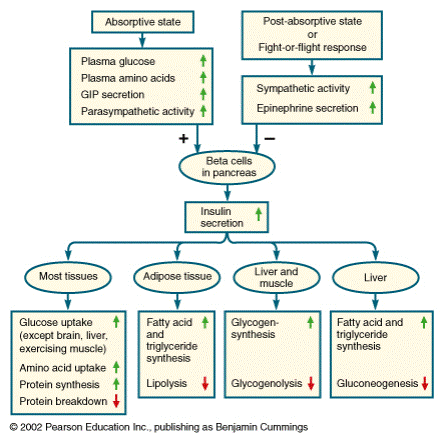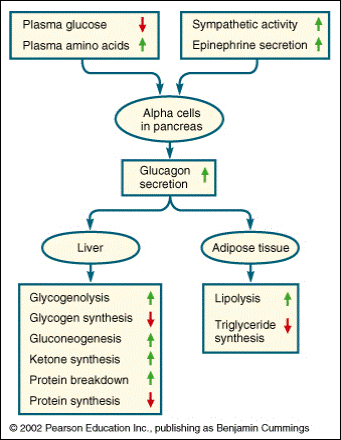


 علم الكيمياء
علم الكيمياء 
 الكيمياء التحليلية
الكيمياء التحليلية 
 الكيمياء الحياتية
الكيمياء الحياتية 
 الكيمياء العضوية
الكيمياء العضوية 
 الكيمياء الفيزيائية
الكيمياء الفيزيائية
 الكيمياء اللاعضوية
الكيمياء اللاعضوية 
 مواضيع اخرى في الكيمياء
مواضيع اخرى في الكيمياء
 الكيمياء الصناعية
الكيمياء الصناعية |
Read More
Date: 16-1-2016
Date: 6-12-2015
Date: 16-3-2016
|
Blood Sugar
When we refer to ‘blood sugar’, we actually mean the monosaccharide (simple sugar) glucose dissolved in the blood. Maintaining a stable blood glucose concentration is necessary in order to keep it high enough to ensure normal functioning of the brain, whilst also preventing the harmful consequences which can arise when the concentration is too high.
The normal concentration of glucose is about 3.5- 5.5 mmol/litre (60-90 mg/L) and this is referred to as euglycaemia, or normal blood glucose. When blood glucose falls below 3.5 mol/litre(60 mg/L), hypoglycaemia is beginning to develop. If it falls to 2 mmol (35 mg)/L there is loss of consciousness (hypoglycaemic coma). A person would be diagnosed as having diabetes if their blood glucose after an overnight fast exceeded 7.0 mmol/litre: this is called hyperglycaemia, an abnormally high blood glucose.
The figure shows a typical 24-hour profile of blood glucose concentration. The concentration can increase rapidly after consumption of simple sugars, especially glucose itself, either in a drink or in tablet form. This will provide a more rapidly available source of energy than would occur with starchy food.

Typical 24-hour profile of blood glucose concentration
Regulation of blood glucose level:
1-Hormonal regulation:
Carbohydrates:
Fat: stimulate lipogenesis and inhibit Ketogenesis by the following mechanism:
Inhibits hormone-sensitive lipase in adipocytes. Increases TG synthesis by increasing activity of acetyl CoA carboxylase; increases intracellular glucose concentration which increases glycerol 3-P; and increases lipoprotein lipase activity in adipose tissue.
Protein: protein synthesis↑

Regulation of plasma glucose concentration by insulin
They opposes the metabolic actions of insulin. The important metabolic effects include: they decrease the glucose transporter across the cells, ↑gluconeogenesis, ↑glycogenolysis and↓glycogen synthesis.
They are:
Carbohydrates:↑gluconeogenesis, ↑glycogenolysisand ↓glycogen synthesis
Fat:↑Ketogenesis
Protein:↓Hepatic protein synthesis and ↑protein catabolism in the liver
N.B: Glucagon DOES NOT affect muscle proteins.

Factors affecting glucagons secretion and actions

Regulation of energy metabolism by sympathetic nervous activity
and circulating epinephrine in response to a fall in plasma glucose levels
2- Hepatic regulation:
Liver regulate the blood glucose level according to the fed stat:
3- Renal regulation:
Glucose is filtered through kidney, but if it exceed the renal threshold (180 mg/dl), it start to appear in urine
Types of diabetes:



|
|
|
|
دراسة يابانية لتقليل مخاطر أمراض المواليد منخفضي الوزن
|
|
|
|
|
|
|
اكتشاف أكبر مرجان في العالم قبالة سواحل جزر سليمان
|
|
|
|
|
|
|
اتحاد كليات الطب الملكية البريطانية يشيد بالمستوى العلمي لطلبة جامعة العميد وبيئتها التعليمية
|
|
|